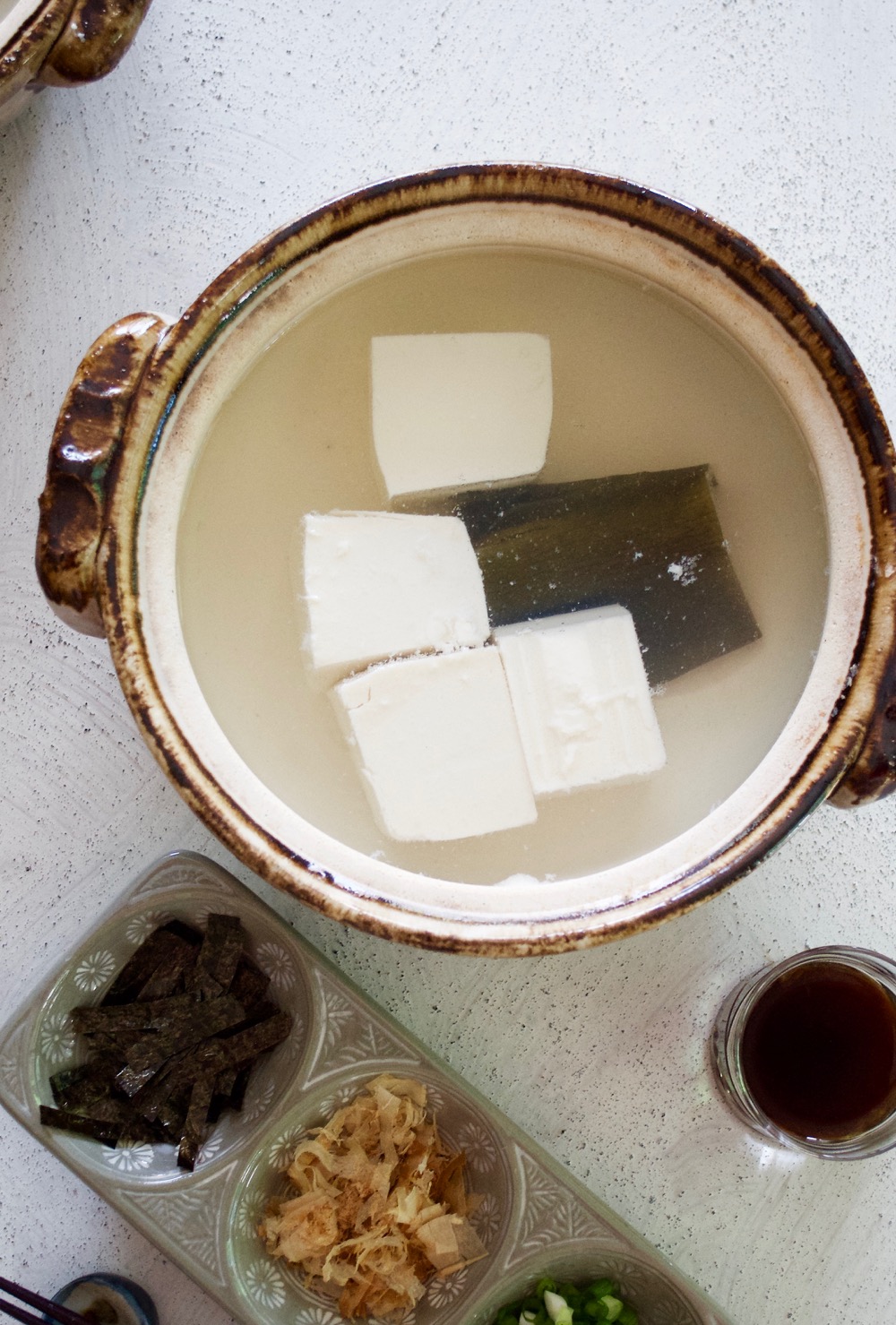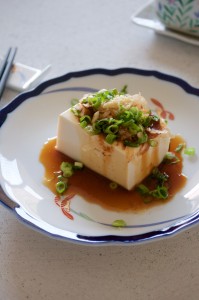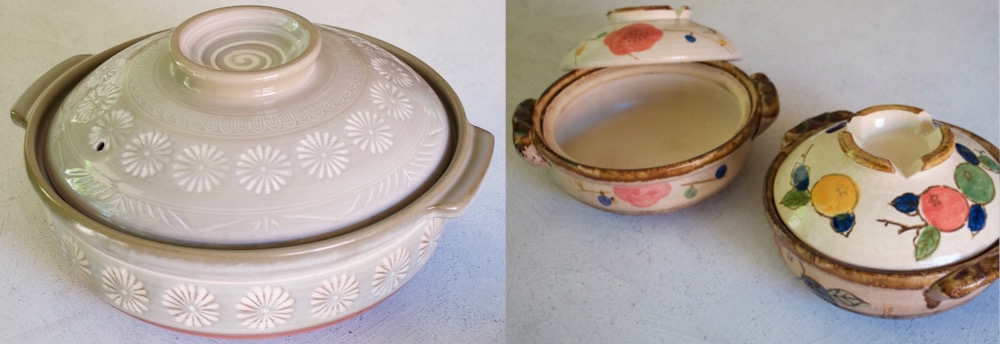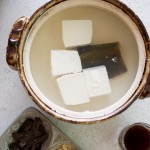Yudofu (Tofu Hot Pot) is one of the simplest tofu dishes and the simplest hot pot. When I feel like a quick light meal in cold winter, I always settle with yudofu. This is also a perfect vegetarian dish.

Yudofu (湯豆腐) is the second simplest tofu dish after hiyayakko (冷奴, cold tofu topped with garnish and soy sauce), in my view. This is because you would have to cook the tofu to make yudofu while hiyayakko needs no cooking. While hiyayakko is normally eaten during summer, yudofu is best eaten in winter.

The simplest tofu dish, hiyayakko. Cold tofu topped with shallots, grated ginger, bonito flakes, and pour over soy sauce.
Yudofu is also a simple nabe (鍋) recipe (hot pot recipe). All you need to do is warm up tofu pieces in water with konbu (昆布, kelp) in it and then eat it with dipping sauce. It’s as simple as that! Some Japanese households might add vegetables but real yudofu is just tofu in a hot pot.
Japanese hot pot is usually cooked in a clay pot called donabe (土鍋). The size of donabe varies but most Japanese household would have a family size donabe which is anywhere between 25cm ~ 35cm in diameter.
My family size donabe is about 30cm in diameter with a 4L capacity. This size donabe is sold as suitable for 5-6 people but as you probably know already, my kids and I eat a lot so this is just right for the four of us.
There are small donabe for individual serving, too. Its diameter is about 17cm ~ 19cm. Small donabe are used to serve individual hot pot or to cook udon (うどん) noodles called nabeyaki udon (鍋焼きうどん) which I will introduce to you in a future post. It’s an udon noodle soup with lots of toppings.

Family size donabe on the left, individual small donabe on the right.
If you make yudofu in a donabe it will create an authentic atmosphere and the tofu will be kept warm much longer than in a normal pot. But, you can still make it in a normal pot or perhaps a Corningware which you can use on stovetop. A lid is not required to make yudofu.
The dipping sauce can be either soy sauce based or sesame based. There are many variations but my family normally eat it with either citrus flavoured soy sauce called ponzu (ポン酢) or sesame sauce called gomadare (ゴマだれ) because I was brought up in Tokyo. In Kyoto, yudofu dipping sauce would not contain citrus, but would be more like a noodle soup flavour which is slightly sweet.
 You can make ponzu and gomadare at home. Please visit my post Japanese Dressings for the recipes to make ponzu and gomadare. You can also buy dipping sauces at Asian grocery stores. The only problem with the store bought dipping sauces is that they come in 200-250ml bottles. You wouldn’t consume it at once and may not use it again for a long time and it might reach to Used By date before the next occasion, unless of course you cook Japanese dishes often.
You can make ponzu and gomadare at home. Please visit my post Japanese Dressings for the recipes to make ponzu and gomadare. You can also buy dipping sauces at Asian grocery stores. The only problem with the store bought dipping sauces is that they come in 200-250ml bottles. You wouldn’t consume it at once and may not use it again for a long time and it might reach to Used By date before the next occasion, unless of course you cook Japanese dishes often.
Since I do not have a suitably sized donabe or pot for 2 people (i.e. 2 servings) to make yudofu, I made it in an individual donabe as you can see in the photo. However, the recipe below is written to make two servings in one pot.
Yumiko![]()
PS. You can even eat konbu used in yudofu. It is believed that eating konbu every day keeps your hair healthy and black (for Japanese) even when you get older and no grey hair! Alas, I should have eaten konbu every day but it’s too late now.

- 1-2 packs of silken tofu (Note 1)
- 5cm (2") x 10cm (4") strip of konbu (kelp) cut into half
- Ponzu or gomadare (please refer to Japanese Dressings)
- 2 tbsp finely chopped shallots/ scallions
- 1 tbsp katsuobushi (dried bonito flakes)
- 1 tbsp julienned yaki nori (roasted seaweed sheet), about 2-3cm / 1 inch length
-
Using a paper towel, gently wipe any dust off the konbu but do not scrub hard and do not remove the white powder stuck on the surface of the konbu as it contains umami.
-
Fill the donabe/pot with enough water to cover the entire tofu. Add the konbu in the donabe/pot and leave it for 30 min without heat on. This is to let umami from the konbu come out and mix into the water.
-
Take the tofu out of the pack and place it onto your palm. Cut the tofu into 6 cubes, i.e. one cut length wise and two cuts perpendicular to the first cut.
-
Gently place the tofu into the donabe/pot with konbu in it and turn the heat on to medium heat.
-
When the tofu pieces started moving due to the small bubbles from the boiling water, turn the heat off and serve immediately (Note 3) with the dipping sauce.
-
Make ponzu and/or gomadare as per the recipe in Japanese Dressings.
-
Transfer the sauce to a serving container.
-
Add dipping sauce of your choice to a serving bowl.
-
Pick up a pice of tofu from the pot (only the tofu without liquid) and place it in the serving bowl.
-
Top with garnish. You could also add garnish in the dipping sauce first if you like.
-
You may need to top up with the dipping sauce half way if it becomes bland.
1. The size of tofu in a pack is about 11cm x 8cm x 4cm (4⅜" x 3⅛" x 1½"). I like the texture of silken tofu as it is more delicate but you can use firm tofu (momen-dofu) if you prefer. It is really your choice but do not use extra firm tofu as you will not enjoy the texture of the tofu. I have talked more about different tofu in the post Tofu With Vegetable Sauce if you are interested.
2. I had these three kinds of garnish on hand so I listed them here. But other garnish you could use are grated ginger, shichi-mi tougarashi (七味唐辛子, seven-flavour chilli peppers), momiji oroshi (紅葉おろし) which is grated daikon with dried chillies (make few holes in daikon, put chilli into each hole, then grate daikon).
4. If you have a portable cooktop, it would be ideal to cook the tofu at the table, especially if you are serving a few people. In that case, leave the tofu in a bowl full of water and when the water in the pot gets heated take as many tofu pieces as you can eat at one time and cook them in the pot. This way, you can eat perfectly cooked tofu every time.
Hi Yumiko,
I was wondering if you ever got around to posting a recipe for the nabeyaki udon mentioned in this post? I can’t see it on the website, but may have missed it?
Many thanks,
Pat.
Hi Pat, no I haven’t, I am so sorry. It’s long over due! I need to work on it as soon as possible.
Thanks to my father who stated to me concerning this web site,
this website is really awesome.
Thanks! Please pass my big “thank you” to your father, too.
Hi Yumiko,, I’m wondering if I can use wakeme seaweed for this dish?
Thanks
Yummymummy
Hi Yummymummy, wake is not the seaweed to get stock out of it. The purpose of using knob in this dish is to get a bit of flavour to the broth. But you don’t have to have it as the cooked tofu will be eaten with dipping sauce.
What I would suggest is that, instead of leaving wake pieces in the pot for 30min, add them together with tofu so that they won’t be over cooked.